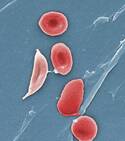
10 Dec ASH23: Nemours Study Links Pain Scores with Return ED Rates in Children with Sickle Cell Disease
MedicalResearch.com Interview with:

Dr. Brousseau
David Brousseau, MD, MS
Chair of Pediatrics
Nemours Children’s Health, Delaware and the
Sidney Kimmel Medical College at Thomas Jefferson University
MedicalResearch.com: What is the background for this study?
Response: Sickle cell disease (SCD) is an inherited red blood cell disorder – the most common genetic disorder in the United States, affecting about 100,000 Americans (1 of every 365 Black births and 1 of every 16,3000 Hispanic-American births) (source: CDC).
Pain is its most common symptom. Patients may experience acute or chronic pain or both. Acute episodes of pain, or pain crises, can vary in duration and severity. Many are treated at home; however when the pain is excruciating and cannot be treated at home, they lead to Emergency Department (ED) visits and even hospitalization.
Reducing pain through prompt administration of pain medication in the ED is a core principle of national guidelines for SCD care. However, little data exists on how pain scores and changes in pain scores in the ED are associated with the patient’s disposition and the odds of a return visit.
MedicalResearch.com: What are the main findings?
Response: In this multicenter, retrospective cohort study, we analyzed acute pain scores from ED index (initial) visits for children with uncomplicated Sickle cell disease pain crisis to determine the relationships between pain scores and disposition (admission or discharge) or occurrence of a return ED visit within 14 days if discharged. Of the 4,985 ED index visits analyzed, the overall median initial pain score was 8.0, the median last pain score was 5.0, and the median change in pain score was 2.0.
Higher initial and last ED pain scores, as well as a small change in ED pain scores, were all associated with higher hospitalization rates – with the last pain score being the best predictor of admission. More than 80% of children with a last pain score of 7 or higher (52% of all visits analyzed) were hospitalized.
Of the 2,377 visits that were originally discharged to home, 29% returned to the ED within 14 days. None of the initial visit pain scores, or changes in pain score, were associated with these returns. However, receiving more opioid doses in the initial ED visit and not receiving a prescription for an opioid at discharge were both associated with increased return visits

Sickle Cell
CDC Image
MedicalResearch.com: What should readers take away from your report?
Response: We found that for a child with Sickle cell disease presenting to the ED with an uncomplicated pain crisis, the last ED pain score was the best predictor of hospitalization.
When trying to identify children at high risk for return within 14 days, receiving more opioid doses at the initial visit and not receiving an opioid prescription at discharge were associated with more return visits.
MedicalResearch.com: What recommendations do you have for future research as a results of this study?
Response: Further research into risk factors for high return visit rates, possibly in conjunction with early post-discharge data, may allow for targeted interventions to decrease this unacceptably high return visit rate.
MedicalResearch.com: Is there anything else you would like to add? Any disclosures?
Response: This study helps fill an important gap in knowledge of indicators for return ED visits due to SCD pain crises. Bringing acute SCD pain under control quickly is essential to managing the pain from this disease so that patients need fewer visits to the ED.
Disclosures (Brousseau): CSL Behring, consultancy, honoraria
Citation:
Presented at American Society of Hematology Annual Meeting & Exposition (ASH23)
Keli D. Coleman, Kenneth McKinley, Angela M. Ellison, Elizabeth R. Alpern, Selena Hariharan, Irina Topoz, Morgan Wurtz, Blake Nielsen, Lawrence J. Cook, Claudia R. Morris, Amanda M. Brandow, Andrew D. Campbell, Robert I. Liem, Rachelle Nuss, Charles T. Quinn, Alexis A. Thompson, Anthony Villella, Allison A. King, Ana Baumann, Warren Frankenberger, David C. Brousseau,
Association between Acute Pain Scores in Children with Sickle Cell Disease and Emergency Department Disposition and Return Visit Rates,
Blood,Volume 142, Supplement 1,2023,Page 3874,ISSN 0006-4971,
https://doi.org/10.1182/blood-2023-180273
The information on MedicalResearch.com is provided for educational purposes only, and is in no way intended to diagnose, cure, or treat any medical or other condition.
Some links may be sponsored. Products are not endorsed.
Always seek the advice of your physician or other qualified health and ask your doctor any questions you may have regarding a medical condition. In addition to all other limitations and disclaimers in this agreement, service provider and its third party providers disclaim any liability or loss in connection with the content provided on this website.
Last Updated on December 10, 2023 by Marie Benz MD FAAD
